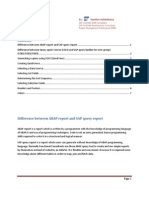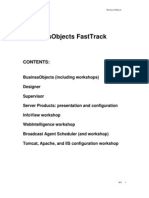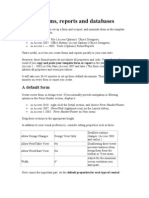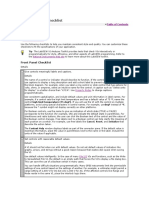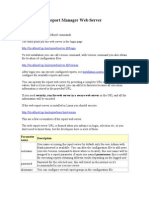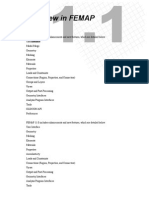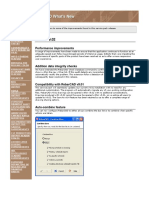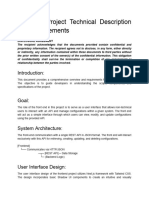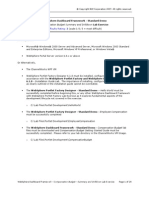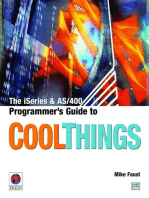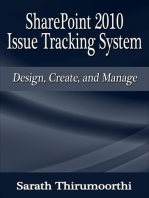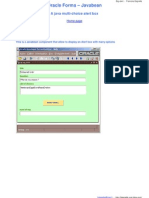What's New: BMC Remedy Action Request System
What's New: BMC Remedy Action Request System
Uploaded by
vinodxtyagiCopyright:
Available Formats
What's New: BMC Remedy Action Request System
What's New: BMC Remedy Action Request System
Uploaded by
vinodxtyagiOriginal Title
Copyright
Available Formats
Share this document
Did you find this document useful?
Is this content inappropriate?
Copyright:
Available Formats
What's New: BMC Remedy Action Request System
What's New: BMC Remedy Action Request System
Uploaded by
vinodxtyagiCopyright:
Available Formats
Whats New
BMC Remedy Action Request System
Version 7.6.04 January 28, 2011
This document summarizes the main features added to the 7.6.04 version of BMC Remedy Action Request System (AR System). The following topics are provided:
! ! ! !
Installation enhancements (page 2) User interface enhancements (page 2) Preserving customizations with overlays and custom objects (page 8) Other enhancements (page 10)
194226 194226
*194226*
Installation enhancements
Installation enhancements
The following installation enhancements and new features have been added:
!
Additional platform support for BMC Remedy ITSM Suite Preconfigured Stack 7.6.04 installation Set Server Info command for plug-in server restart
Additional platform support for BMC Remedy ITSM Suite Preconfigured Stack 7.6.04 installation
BMC Remedy ITSM Suite Preconfigured Stack version 7.6.04 installer is now available on the following new operating system and database combination:
!
Red Hat Enterprise Linux 5 (Update 5) (64-bit) with Oracle 11g Release 2 (64-bit)
The installer continues to support the following operating system and database combinations:
!
Microsoft Windows Server 2008 (64-bit edition) (Standard, Enterprise, or Datacenter) with Microsoft SQL Server 2008 (64-bit) (Standard or Enterprise) Oracle Solaris 10 with Oracle 11g Release 2 (64-bit) (Standard, Enterprise, or RAC)
For a detailed list of installed applications, the installation procedure, the system requirements, and the hardware and software requirements, see the BMC Remedy ITSM Suite Preconfigured Stack 7.6.04 Installation Notes. Use the existing installer for installing only AR System version 7.6.04 or for upgrading to version 7.6.04. For more information, see the Installation Guide.
Set Server Info command for plug-in server restart
When changes such as C plug-in or Java plug-in related changes, binary updates during installation, plug-in related updates to the ar.conf file, or changes to the pluginsvr_config.xml file are made to the C plug-in or Java plug-in files, you can restart only the plug-in server instead of the AR System server. For information about the steps required for restarting the plug-in server by using the set server information command (ssi), see the Integration Guide.
User interface enhancements
The following user interface enhancements and new features have been added:
! ! !
AR System server integration with BMC Atrium Single Sign-On (SSO) solution Individual border-width control on panel fields New Modifier keywords for use in workflows
Whats New
January 28, 2011
User interface enhancements
! ! ! ! ! ! ! ! ! ! ! !
Enhanced drag-and-drop capability Table tree view restyled to folder view Ability to add context menus for tables Ability to group tables with count Vertical text option for trim text fields Enhanced auto-completion Ability to add, move, and resize floating panels New prompt bar for web clients Ability to highlight required fields by using a workflow New Popup window type for Open Window action Enhancements to flashboards New alignment for list view table cells
AR System server integration with BMC Atrium Single Sign-On (SSO) solution
In this release of BMC Remedy AR System, the AR System server is integrated with the BMC Atrium Single Sign-On (SSO) solution by introducing a new Atrium SSO plug-in. To configure this plug-in, you must provide values for the following configuration parameters on the new Atrium SSO Integration tab, located on the AR System Administration: Server Information form:
! ! ! ! !
Atrium-SSO-Location Atrium-SSO-Admin-User Atrium-SSO-Admin-Password Atrium-SSO-Keystore-Path Atrium-SSO-Keystore-Password
Alternatively, you can also configure the Atrium SSO server while installing the AR System server. To do this, you must provide the values for the configuration parameters on the new Atrium SSO Configuration screen after selecting the Configure Atrium SSO check box. For the mid tier and BMC Atrium SSO integration, you must configure the mid tier either by using the installer or by performing some manual steps. If you selected the mid tier component while installing AR System server, you must provide the values for the following parameters during installation:
! ! ! ! !
Atrium-SSO-Location Atrium-SSO-Admin-User Atrium-SSO-Admin-Password Atrium-SSO-Truststore-Path Atrium-SSO-Truststore-Password
BMC Remedy Action Request System
Version 7.6.04
User interface enhancements
If you choose to perform a stand-alone installation of the mid tier, then you must provide the values for the following parameters along with the parameters mentioned above during installation:
! ! ! ! !
AR System server name alias AR System server Administrator Name AR System server password AR System server TCP Port Host Name or IP address
For information about the configuration steps for the mid tier, see Manually configuring the mid tier for Atrium SSO user authentication in the Integration Guide.
NOTE
Only the web client supports BMC Atrium SSO Integration.
NOTE
By default, the Atrium SSO plug-in is configured to work with the native plug-in server (C plug-in). You can also use this plug-in directly with the Java plug-in server. For more information about the configuration settings, see the Integration Guide.
Individual border-width control on panel fields
You can control the thickness of borders on Panel fields with the new Border Thickness field property. To create a border with the same number of pixels on all sides, enter a single number, which will be applied to all the borders. To create a border with varying thicknesses, enter the number of pixels for each side in the following order: Top, Right, Bottom, Left. Separate each entry with a comma. Enter 0 for no border. For more information, see the Form and Application Objects Guide.
New Modifier keywords for use in workflows
The following modifier keywords can help verify whether a user has pressed the Shift, Alt, or Control keyboard modifier keys:
! ! !
$SHIFT_KEY$ $ALT_KEY$ $CTRL_KEY$
You can define a workflow in BMC Remedy Developer Studio by using the modifier keywords on a Control field such as push button, url-style button, or image button. You can also execute this action on a table field. For more information, see the Workflow Objects Guide.
Whats New
January 28, 2011
User interface enhancements
Enhanced drag-and-drop capability
You can now select and then drag-and-drop multiple rows from one table to another table. To select the rows for dragging, you must press the CTRL button as you select each row. To drag-and-drop the rows, release the CTRL button, press the mouse cursor on any of the selected rows, and drag the multiple rows to the other table. During the drag sequence, you can configure a drag proxy to appear and display the number of items being dragged. You can insert a label (such as items selected) next to the number. For more information, see the Workflow Objects Guide.
Table tree view restyled to folder view
The appearance of the table tree view has changed. To open and close the nodes, the plus (+) and minus (-) signs are replaced by the twisty-right ( ) and twistydown ( ) symbols. The connecting lines between the nodes are also removed. Also, when you select a node (click anywhere on the node), the entire row is highlighted instead of only the corresponding element being highlighted.
NOTE
This change in appearance is seen in the table tree views and in the tree-styled menus. For more information, see the Form and Application Objects Guide.
Ability to add context menus for tables
You can define a custom context menu for individual AR System table objects including list view tables, tree view tables, and cell-based tables. This context menu, created by using BMC Remedy Developer Studio, can contain menu items and sub-menu items with unique IDs. You can attach this context menu to a table field of any display type. You can perform the following operations on custom context menus:
!
Use BMC Remedy Developer Studio to change the order of the menu items and their labels. Use a workflow to enable or disable the menu items. Use a workflow to hide or show the menu items.
! !
For more information, see the Form and Application Objects Guide.
BMC Remedy Action Request System
Version 7.6.04
User interface enhancements
Ability to group tables with count
For forms that are viewed in a browser, you can group table rows in list view tables. You can expand these logical groups (or folders) to view a subset of table rows. Groups are created by using the data that you enter into the field. For example, if you select the Status field to organize groups, the rows of the table are grouped by each status option (for example, Draft, Open, Rejected, and so on). Additionally, you can include a count, which displays how many rows are included in the section. For more information, see the Form and Application Objects Guide.
Vertical text option for trim text fields
A new property, Text Rotation, has been added to trim text fields in BMC Remedy Developer Studio. The Text Rotation property enables you to specify the angle of the text (0o, 90o, or 270o) being displayed. For more information, see:
! !
Form and Application Objects Guide C API Reference
Enhanced auto-completion
The automatic complete feature is improved to handle large data sets in search menus that are attached to a character field (for example, over 10,000 entries). This feature also minimizes unwanted searches. For more information, see the Form and Application Objects Guide.
Ability to add, move, and resize floating panels
You can create a panel or panel holder that overlaps a form. For example, you might want to superimpose a panel on a layout that contains other fields. These panels are called floating panels. Floating panels can be modeless, which means that the panel is part of the form, and you can interact with the panel and the base form interchangeably. Floating panels can also be modal, which means that you cannot interact with the base form until you close the panel. For more information, see the Form and Application Objects Guide.
New prompt bar for web clients
If you select the Show Message in Prompt Bar check box for a Message active link action, then Notes, Warning, or Error messages are displayed in the prompt bar below the web toolbar. (The check box is ignored for Prompt, Accessible, and Tooltip messages.) For more information, see the Workflow Objects Guide.
Whats New
January 28, 2011
User interface enhancements
Ability to highlight required fields by using a workflow
In earlier versions of AR System, the AR System server validated required fields. Beginning with release 7.6.04, the BMC Remedy Mid Tier validates required fields. AR System application developers can use the PERFORM-ACTION-VALIDATENULL-REQUIRED-FIELDS run process command to create a workflow that checks for missing data in required fields. The command highlights the required fields (for example, with red color borders) that are empty and displays an error message. Performance improves because the workflow does not require calls to the server.
NOTE
The workflow highlights required fields in browser clients only. The PERFORMACTION-VALIDATE-NULL-REQUIRED-FIELDS command is not supported in BMC Remedy User. For more information, see the Workflow Objects Guide.
New Popup window type for Open Window action
A new window type, Popup, has been added for the Open Window workflow action. This provides a pop-up appearance for a window in browser clients. You can use a pop-up window to prompt for user input and then transfer that input to the parent form in the browser client. The Popup window type cannot be decoupled from the parent window. It appears as a child window at the center of the parent window, and closes automatically when you close the parent window. BMC Remedy Mid Tier now supports the Show Close button, which handles the close option on pop-up windows. For more information, see the Workflow Objects Guide.
Enhancements to flashboards
This section describes BMC Remedy Flashboards enhancements.
New chart typeCapacity
A new chart type, Capacity has been introduced to display flashboard data values in percentage format. A Capacity flashboard is a single bar with two or more sections, or multiple bars of equal length stacked one above the other. Each colored bar or section represents a task or an entity. The length of the bar represents 100 percent of the task or entity. The value on each bar or section is the actual value for that task progress or entity group, whereas the tooltip displays its percentage value. For more information, see the BMC Remedy Flashboards Guide.
BMC Remedy Action Request System
Version 7.6.04
Preserving customizations with overlays and custom objects
New flashboard properties
The following properties have been added for flashboards objects:
! ! ! !
Embedded Show X Axis line Show Y Axis line Show Label Inside
For more information, see the BMC Remedy Flashboards Guide.
New alignment for list view table cells
The default horizontal and vertical alignment of list view table cells is updated as follows:
!
Column horizontal alignment: All numeric fields are right-aligned and all other fields are left-aligned. Column vertical alignment: All fields are vertically-aligned to the middle.
Preserving customizations with overlays and custom objects
The following new features have been added for preserving customizations:
! !
Overlays and custom objects Best Practice Conversion utility to help convert pre-7.6.04 objects to overlays and custom objects New development mode in BMC Remedy Developer Studio to enforce best practices Access restricted to overlays, base objects, and custom objects in BMC Remedy Developer Studio based on permission group
Overlays and custom objects
BMC-provided AR System objects are called origin objects. Objects that are modified or created by users are now identified as follows:
!
OverlayAn overlay is a copy of an AR System object that is used in place of the origin object. To make sure that customizations are not lost during upgrades, you modify the overlay, not the origin object. Custom objectA custom object is a stand-alone object created by an AR System user. AR System treats objects created in the Best Practice Customization mode of BMC Remedy Developer Studio as custom objects. These objects are not modified or lost during upgrades.
Whats New
January 28, 2011
Preserving customizations with overlays and custom objects
For more information, see the following documents:
! ! ! ! ! ! ! !
Concepts Guide Installation Guide Form and Application Objects Guide Configuration Guide Optimizing and Troubleshooting Guide Error Messages Guide C API Reference Database Reference
Best Practice Conversion utility to help convert pre7.6.04 objects to overlays and custom objects
AR System now provides featuresoverlays and custom objectsthat help you preserve customizations in the future. To implement these features, you need to install or upgrade to version 7.6.04. To preserve your existing customizations before upgrading to 7.6.04, BMC provides the Best Practice Conversion utility. Use the Best Practice Conversion utility to compare AR System objects in your environment to those in the most recent BMC-provided objects. Analyze the comparison report to decide whether to retain your changes or additions, or to retain those provided by BMC in the most recent release. To retain your changes or additions, you must convert the relevant objects to overlays and custom objects by executing the Best Practice Conversion utility in Overlay mode. For more information, see the Installation information section in the BMC Remedy Action Request System 7.6.04 Release Notes.
New development mode in BMC Remedy Developer Studio to enforce best practices
BMC Remedy Developer Studio now opens in the Best Practice Customization mode by default. This new mode allows you to modify overlays and custom objects only. For example, to add a field on a form, you must first create an overlay of the origin form and the view on which you want to add the object. The field is added to the overlay form on the overlay view, and the field itself is saved as a custom object. To make modifications to origin objects (BMC-provided objects), developers must switch to the Base Development mode. In this mode, only unmodified and overlaid origin objects are displayed in object lists; you cannot add custom objects or modify overlays. Changes made to origin objects in this mode might be lost during upgrades. For more information, see the Introduction to Application Development with BMC Remedy Developer Studio.
BMC Remedy Action Request System
Version 7.6.04
Other enhancements
Access restricted to overlays, base objects, and custom objects in BMC Remedy Developer Studio based on permission group
To allow external customers to configure extensions and customizations to their applications, and to make sure that upgrades can be implemented without affecting these changes, AR System sever now includes the following group configuration options:
! !
Struct Admin Struct Subadmin
If a user is granted Admin, Subadmin, Struct Admin, or Struct Subadmin permission, and one of the groups includes an active overlay group value, the user can perform administration operations in the overlay mode, or by using the specified overlay group. Access to modifying overlay group objects does not provide access to administrative functions or data. This restriction is configurable for each user by using the user form. The codes IDs 8 and 9 are now hard coded for the Struct Admin and Struct Subadmin groups. If you have assigned these IDs to custom groups, you must assign new IDs to those groups before you upgrade if you want to restrict access to BMC Remedy Developer Studio. For more information, see the following documents:
! ! ! ! !
Introduction to Application Development with BMC Remedy Developer Studio Form and Application Objects Guide Configuration Guide Error Messages Guide C API Reference
Other enhancements
The following miscellaneous enhancements and new features have been added:
! ! ! ! ! ! !
OSGi-compliant AR System Java API 64-bit JVM support for Java plug-in server and Full Text Search Ability to reduce memory usage during search Ability to render inline forms in view fields Distributed Server Option enhancements Workflow support for efficiently handling displayed objects Ability to specify values of duplicate field IDs for multiple schemas by using the BMC Remedy Data Import command-line utility New load balancer configuration options
10
Whats New
January 28, 2011
Other enhancements
! !
New application command for FTS ad hoc reindexing Improved language in error messages
OSGi-compliant AR System Java API
The AR System Java API is shipped as an arapiVerNum.jar file. In release 7.6.04, the AR System Java API is also shipped as an OSGi bundle with the file name com.bmc.arsys.apiVerNum.jar file. Like any other OSGi-compliant bundle, you can deploy the AR System Java API OSGi bundle in an OSGi container that caters to modular Java development. For information about the AR System Java API, see the C API Reference. For information about the OSGi framework and OSGi compliance, visit: http://www.osgi.org.
64-bit JVM support for Java plug-in server and Full Text Search
In release 7.6.04, additional 64-bit Java Virtual Memory (JVM) support has been provided for the Java plug-in server and Full Text Search (FTS). When installing AR System 7.6.04 on a 64-bit platform, you can choose whether all the Java components of AR System use a 64-bit or a 32-bit JVM. On 32-bit operating system platforms, Java components are automatically installed as 32-bit. For more information, see the Installation Guide.
Ability to reduce memory usage during search
When multiple users perform unqualified searches, or when the search results contain large amount of data, BMC Remedy Mid Tier consumes large amount of memory. This might result in out-of-memory errors. In this release, you can use chunked transfer encoding to avoid these errors. Chunked transfer encoding breaks the search result into small chunks and streams the result to the browser. This significantly reduces the mid tier memory usage during search operations. To enable chunked transfer encoding, you configure the arsystem.min_entries_for_streaming property in the config.properties file. For more information, see the Enterprise Quick Reference White Paper.
Ability to render inline forms in view fields
You can set the Inline Form property for AR System forms that are embedded in view fields. Using inline forms reduces the number of open windows and provides the appearance of a single form. Inline forms support the Form-in-Form feature and improve performance in BMC Remedy Mid Tier. You can set the Inline Form property to an AR System form while defining a workflow by using the Open Window action. For more information, see the Workflow Objects Guide.
BMC Remedy Action Request System Version 7.6.04
11
Other enhancements
Distributed Server Option enhancements
The following enhancements have been made to Distributed Server Option (DSO):
! ! ! !
Distributed logical mapping Support for exclusion list Support for dynamic specification of the distributed pool name C API changes
Distributed logical mapping
You can now configure distributed mappings by using temporary server names. Distributed logical mapping is used to define the mapping between logical and physical server names. At runtime, DSO replaces the logical server name with the physical server name according to the mappings stored in the Distributed Logical Mapping form. This eliminates the need to manually replace the server names while moving the configuration from a development environment to a production environment. With the custom mapping option, you can also use distributed logical mapping to assign a logical constant string value for fields whose actual value is unknown while developing the distributed mappings. For more information, see the BMC Remedy Distributed Server Option Guide.
Support for exclusion list
While creating distributed mappings, you can now select a list of fields that you want to exclude from mapping for Like Field IDs or Like Field Names mapping type. DSO avoids mapping these fields for the DSO transfer or return action. For more information, see the BMC Remedy Distributed Server Option Guide.
Support for dynamic specification of the distributed pool name
You can now select either the Distributed Pools or the Fields from which you want to source the distributed pool name. For more information, see the BMC Remedy Distributed Server Option Guide.
C API changes
The following C API functions are modified:
!
ARGetDSOMappingFromXML The following return values have been added:
char char **excludeFlds **rtnExcludeFlds
12
Whats New
January 28, 2011
Other enhancements
ARSetDSOMappingToXML The following input arguments have been added:
char char **excludeFlds **rtnExcludeFlds
ARMergeEntry This function has been modified to improve DSO performance. The following input arguments have been added:
ARQualifier unsigned int *query multimatchOption
For more information, see the C API Reference.
Workflow support for efficiently handling displayed objects
! ! !
Ability to modify data on display forms Ability to change form mode Ability to modify the toolbar option
Ability to modify data on display forms
AR System displays entries on the forms in Modify or Display mode. In this release, you can reuse these forms by embedding them on the View Fields that are present on a container form. Then, you can edit the entries without reloading the complete form into the browser or the View Field. This speeds up the process of reloading the data on the form. Using the PERFORM-ACTION-GET-ENTRY command, you can create an active link on any action. For more information, see the Workflow Objects Guide.
Ability to change form mode
AR System supports changing the form mode such as Search, Request, Modify All without refreshing the entire browser window. Using the PERFORM-ACTIONCHANGE-MODE command, you can define an active link for that event on Form A to change the mode. For more information, see the Workflow Objects Guide.
Ability to modify the toolbar option
AR System allows to handle the display property of the toolbar on forms and view fields by using the PERFORM-ACTION-SHOW-TOOLBAR command. You can set the property to hide the toolbar when you open the form on a view field and display the toolbar when you open on a browser window. This allows you to use the toolbar when the form is in New Search mode or Modify All mode. Note that this option is available in browser client only. For more information, see the Workflow Objects Guide.
BMC Remedy Action Request System Version 7.6.04
13
Other enhancements
Ability to specify values of duplicate field IDs for multiple schemas by using the BMC Remedy Data Import command-line utility
You can now specify multiple values for multiple schemas by specifying the schema names and the values by using the -e option of the Data Import commandline utility. The Data Import utility continues to support multiple values for a single schema. For more information, see the Integration Guide.
New load balancer configuration options
If your AR System uses a hardware load balancer between the mid tier servers and AR System servers, BMC recommends configuring that load balancer without using a sticky bit by using the Connection Settings page in the BMC Remedy Mid Tier Configuration tool. For more information, see the BMC Remedy Mid Tier Guide.
New application command for FTS ad hoc reindexing
The Application-FTS-Reindex-Form command is added to allow re-indexing of updated entries for a designated regular form: For more information, see Table C-2 in the Workflow Objects Guide.
Improved language in error messages
The Error Messages Guide has been updated with improved error message texts and descriptions, new error messages, and deprecations. For more information, see the Error Messages Guide.
Copyright 2011 BMC Software, Inc. BMC, BMC Software, and the BMC Software logo are the exclusive properties of BMC Software, Inc., are registered with the U.S. Patent and Trademark Office, and may be registered or pending registration in other countries. All other BMC trademarks, service marks, and logos may be registered or pending registration in the U.S. or in other countries. All other trademarks or registered trademarks are the property of their respective owners. Linux is the registered trademark of Linus Torvalds. Oracle and Java are registered trademarks of Oracle and /or its affiliates. Other names may be trademarks of their respective owners. The information included in this documentation is the proprietary and confidential information of BMC Software, Inc., its affiliates, or licensors. Your use of this information is subject to the terms and conditions of the applicable End User License agreement for the product and to the proprietary and restricted rights notices included in the product documentation. BMC SOFTWARE INC 2101 CITYWEST BLVD, HOUSTON TX 77042-2827, USA 713 918 8800 Customer Support: 800 537 1813 (United States and Canada) or contact your local support center
14
Whats New
January 28, 2011
You might also like
- O9 Academy - Creating A Model - Beginner's Guide - Quiz - Creating A Model - Beginner's Gu..Document14 pagesO9 Academy - Creating A Model - Beginner's Guide - Quiz - Creating A Model - Beginner's Gu..Swarnika Sinha0% (2)
- Thomson - Risk Rating The Audit UniverseDocument10 pagesThomson - Risk Rating The Audit UniversepradanyNo ratings yet
- SAP Quick Viewer - SQVIDocument7 pagesSAP Quick Viewer - SQVIsandunsulakshana100% (1)
- Pro ReportDocument56 pagesPro ReportGraham MooreNo ratings yet
- SAS Visual Analytics TrainingDocument16 pagesSAS Visual Analytics TrainingBidwhNo ratings yet
- CATIA V5-6R2015 Basics - Part I : Getting Started and Sketcher WorkbenchFrom EverandCATIA V5-6R2015 Basics - Part I : Getting Started and Sketcher WorkbenchRating: 4 out of 5 stars4/5 (10)
- ATE Application Enhancement Tool Overview 1Document8 pagesATE Application Enhancement Tool Overview 1georgetodorov23No ratings yet
- AP0128 Managing Design Variation With VariantsDocument29 pagesAP0128 Managing Design Variation With VariantsdrakenhavenNo ratings yet
- Teched Businessobjects Fasttrack: ContentsDocument13 pagesTeched Businessobjects Fasttrack: Contentslpm40No ratings yet
- ESight 2019.1 Release NotesDocument6 pagesESight 2019.1 Release NotesFUCKUNo ratings yet
- Past ReleasenotesDocument142 pagesPast ReleasenotesJulio Cesar Ceballos RiosNo ratings yet
- TdnotesDocument11 pagesTdnotesDaniel DelarueNo ratings yet
- AET Cookbook v1 3Document14 pagesAET Cookbook v1 3Twesigomwe Gilbert GabrielNo ratings yet
- EPIC-Web Ui ArchitectureDocument82 pagesEPIC-Web Ui Architecturerajesh98765No ratings yet
- Table Maintainance GeneratorDocument25 pagesTable Maintainance GeneratorPramod R DeshpandeNo ratings yet
- Converting To Access 2007Document15 pagesConverting To Access 2007Hemant PatelNo ratings yet
- 70598187Document2 pages70598187บัณฑิต สําเนียงเพราะNo ratings yet
- Introduction To Post BuilderDocument14 pagesIntroduction To Post BuilderKeerthi KumarNo ratings yet
- Default Forms, Reports and DatabasesDocument9 pagesDefault Forms, Reports and DatabasesgeethamadhuNo ratings yet
- Brio IrDocument11 pagesBrio IrSuresh BabuNo ratings yet
- Magic Xpa 3.1 Release NotesDocument32 pagesMagic Xpa 3.1 Release NotesAugust WestNo ratings yet
- Tutorial PHP MakerDocument68 pagesTutorial PHP MakerDeddy Erwin JNo ratings yet
- Femap 11.1 New FeaturesDocument115 pagesFemap 11.1 New FeaturesHans WangNo ratings yet
- Costx 6.8 Release Notes: Headline FeaturesDocument17 pagesCostx 6.8 Release Notes: Headline FeaturesFührer Magdi BadranNo ratings yet
- Itwo Costx 6.9 Release Notes: Headline FeaturesDocument17 pagesItwo Costx 6.9 Release Notes: Headline FeaturesAsif ManerNo ratings yet
- LabVIEW Style ChecklistDocument11 pagesLabVIEW Style ChecklistCesar GarciaNo ratings yet
- Report ManagerDocument82 pagesReport ManagerjiticaNo ratings yet
- Inventor 11 - What's NewDocument15 pagesInventor 11 - What's NewAndrei ANo ratings yet
- Mechanical Engineering News: For The Power, Petrochemical and Related Industries December, 1997Document24 pagesMechanical Engineering News: For The Power, Petrochemical and Related Industries December, 1997HoGSPNo ratings yet
- PowerINSPECT2010 WhatsNew OMVProUserDocument48 pagesPowerINSPECT2010 WhatsNew OMVProUserHector Fabio Vega EspinelNo ratings yet
- FEM Design InstrukcjaDocument383 pagesFEM Design InstrukcjakaspiorNo ratings yet
- Femap 11.1 New FeaturesDocument88 pagesFemap 11.1 New FeaturesdouglascoombsNo ratings yet
- emr250_update_notesDocument19 pagesemr250_update_notesMostafa GomaaNo ratings yet
- Abstract Pro V 6 User GuideDocument11 pagesAbstract Pro V 6 User GuideMamouTechNo ratings yet
- Oracle Applications - BI - XML Publisher Interview QuestionsDocument5 pagesOracle Applications - BI - XML Publisher Interview QuestionsNavya Sai Krishna B100% (1)
- Business Configuration SetsDocument8 pagesBusiness Configuration Setskiran.s4ewmNo ratings yet
- Patch Release 4Document14 pagesPatch Release 4matrix MRX 2016No ratings yet
- BASIC Transformer StageDocument31 pagesBASIC Transformer StageBhuvaneswari MuruganNo ratings yet
- RebarCAD What's New in V9.02Document6 pagesRebarCAD What's New in V9.02balacadsNo ratings yet
- SEI GuideDocument161 pagesSEI GuideruzhaNo ratings yet
- MVTSII Quick Start GuideDocument18 pagesMVTSII Quick Start GuideAshim SolaimanNo ratings yet
- Report Studio: Relational and Dimensional Reporting StylesDocument8 pagesReport Studio: Relational and Dimensional Reporting StylesrajuwithualwaysNo ratings yet
- SOLIDWORKS Configuration (PRODUCTIVITY TOOL)Document15 pagesSOLIDWORKS Configuration (PRODUCTIVITY TOOL)Chinmay ChavanNo ratings yet
- Frontend Project Technical Description and RequirementsDocument11 pagesFrontend Project Technical Description and Requirementsnazakatjoyia23No ratings yet
- Help ToolpathDocument735 pagesHelp Toolpathhoang lyNo ratings yet
- MySQL Activity 2Document17 pagesMySQL Activity 2Jeremias C. EsperanzaNo ratings yet
- What Is New in CR 2008Document4 pagesWhat Is New in CR 2008Priyanka SrinivasuNo ratings yet
- Dynamic C 8 Highlights: Deals With User Interface ChangesDocument9 pagesDynamic C 8 Highlights: Deals With User Interface ChangesimanNo ratings yet
- Websphere Dashboard Framework - Standard Demo Lab Exercise: Compensation Budget Summary and DrilldownDocument25 pagesWebsphere Dashboard Framework - Standard Demo Lab Exercise: Compensation Budget Summary and DrilldownsampreethiNo ratings yet
- Analysis Plug-In User GuideDocument68 pagesAnalysis Plug-In User GuideIgor ProskurnyaNo ratings yet
- SAP EPM Add-In For Microsoft Office: September 9-11, 2013 Anaheim, CaliforniaDocument25 pagesSAP EPM Add-In For Microsoft Office: September 9-11, 2013 Anaheim, CaliforniaAlan ChengNo ratings yet
- Microsoft Dynamics GP 2013 Reporting, Second EditionFrom EverandMicrosoft Dynamics GP 2013 Reporting, Second EditionRating: 5 out of 5 stars5/5 (2)
- The iSeries and AS/400 Programmer's Guide to Cool ThingsFrom EverandThe iSeries and AS/400 Programmer's Guide to Cool ThingsRating: 2.5 out of 5 stars2.5/5 (2)
- SharePoint 2010 Issue Tracking System Design, Create, and ManageFrom EverandSharePoint 2010 Issue Tracking System Design, Create, and ManageRating: 3 out of 5 stars3/5 (1)
- How To Develop A Performance Reporting Tool with MS Excel and MS SharePointFrom EverandHow To Develop A Performance Reporting Tool with MS Excel and MS SharePointNo ratings yet
- Lab 1.3.4 Creating An ACL: CCNA Discovery Designing and Supporting Computer NetworksDocument8 pagesLab 1.3.4 Creating An ACL: CCNA Discovery Designing and Supporting Computer NetworksFery ArdiansyahNo ratings yet
- Building Layouts in Flutter - FlutterDocument26 pagesBuilding Layouts in Flutter - FlutterSiagian HerriNo ratings yet
- Mech AC 160 L03-Bolt PretensionDocument24 pagesMech AC 160 L03-Bolt PretensionPercy Romero MurilloNo ratings yet
- Check Point Security Expert R70: Length Prerequisites Take This Class IfDocument3 pagesCheck Point Security Expert R70: Length Prerequisites Take This Class IfJosimar GuzmanNo ratings yet
- FTVantagePoint Student Manual - 3-29-2013Document878 pagesFTVantagePoint Student Manual - 3-29-2013morrisey75% (4)
- GraphDocument84 pagesGraphRiyaz ShresthaNo ratings yet
- Dheeraj Upadhyay M.Tech - Faculty of Engineering D.E.I, AgraDocument33 pagesDheeraj Upadhyay M.Tech - Faculty of Engineering D.E.I, AgraMuhammad IrfanNo ratings yet
- Contemporary Issues in Marketing ManagementDocument21 pagesContemporary Issues in Marketing ManagementhannaNo ratings yet
- APR-PGM4 Installation Instructions (Spectra)Document2 pagesAPR-PGM4 Installation Instructions (Spectra)nikola5nikolic100% (1)
- Oracle Forms - Javabean: A Java Multi-Choice Alert BoxDocument6 pagesOracle Forms - Javabean: A Java Multi-Choice Alert BoxsssseeeelllleeeeNo ratings yet
- CSC373 Assignment 3 Solutions Spring 2012Document3 pagesCSC373 Assignment 3 Solutions Spring 2012yellowmoogNo ratings yet
- Exercises Classes PDFDocument2 pagesExercises Classes PDFZoha AhmedNo ratings yet
- Quadratic EquationsDocument29 pagesQuadratic EquationsKristine Joyce ArinaboNo ratings yet
- Digital Signal Processing For Deep Space TransponderDocument6 pagesDigital Signal Processing For Deep Space TransponderSatish KapalavayiNo ratings yet
- System32 Exe Fajlovi ObjasnjenjaDocument7 pagesSystem32 Exe Fajlovi ObjasnjenjasnowynsNo ratings yet
- Cobit - AuditoriaDocument16 pagesCobit - AuditoriaJOSE LUIS CARRASCO RODASNo ratings yet
- Digital LOGIC DESIGN Chapter 5,6,7Document32 pagesDigital LOGIC DESIGN Chapter 5,6,7abdishakurNo ratings yet
- Unit II WT NotesDocument32 pagesUnit II WT Noteskishore5783No ratings yet
- Pipeline Applications: Reciprocating Compressor Design StudiesDocument6 pagesPipeline Applications: Reciprocating Compressor Design StudiesISRAEL PORTILLONo ratings yet
- Unit 2 NotesDocument73 pagesUnit 2 NotesSukant LoduNo ratings yet
- SpectraSuite: Spectrometer Operating Software ManualDocument168 pagesSpectraSuite: Spectrometer Operating Software Manualtobago528100% (1)
- SINAMICS G120 PN at S7-1200 DOCU V1d0 enDocument63 pagesSINAMICS G120 PN at S7-1200 DOCU V1d0 engerman_renkNo ratings yet
- Utilizing Amazon S3 and Ec2 in Rails: Jonathan Weiss, Peritor Wissensmanagement GMBH Railsconf Europe Berlin, 2007Document38 pagesUtilizing Amazon S3 and Ec2 in Rails: Jonathan Weiss, Peritor Wissensmanagement GMBH Railsconf Europe Berlin, 2007kaikunNo ratings yet
- Oops JournalDocument75 pagesOops Journalshruti chavanNo ratings yet
- Tic Tac Toe Project Ieee FormatDocument4 pagesTic Tac Toe Project Ieee Formatyalmeeti.saiNo ratings yet
- LISTA CD 2014 Din 17.12.2014Document140 pagesLISTA CD 2014 Din 17.12.2014Dumitrita AnitaNo ratings yet
- Keyboard Shortcut For MacDocument1 pageKeyboard Shortcut For MacDinh Ngoc Lam DienNo ratings yet
- Assign4 RANSDocument2 pagesAssign4 RANSankitsaneetNo ratings yet
- Qubee ReportDocument14 pagesQubee ReportZahidur RezaNo ratings yet



